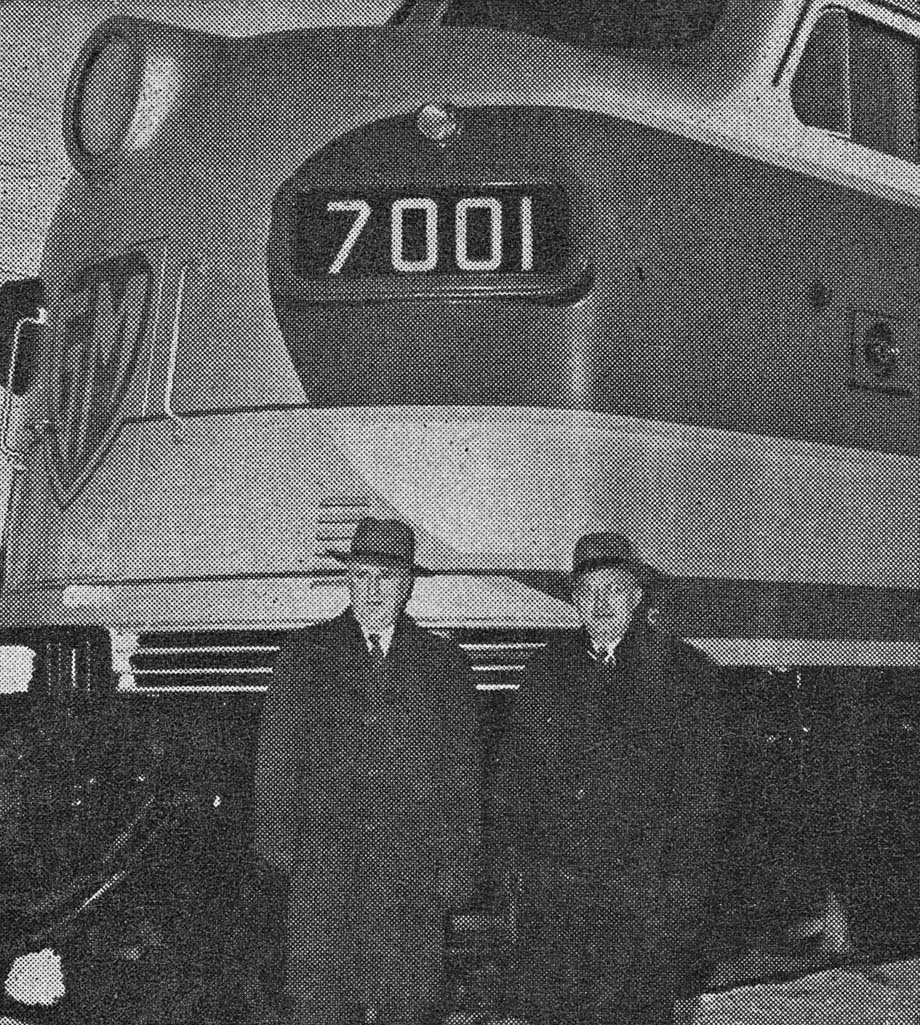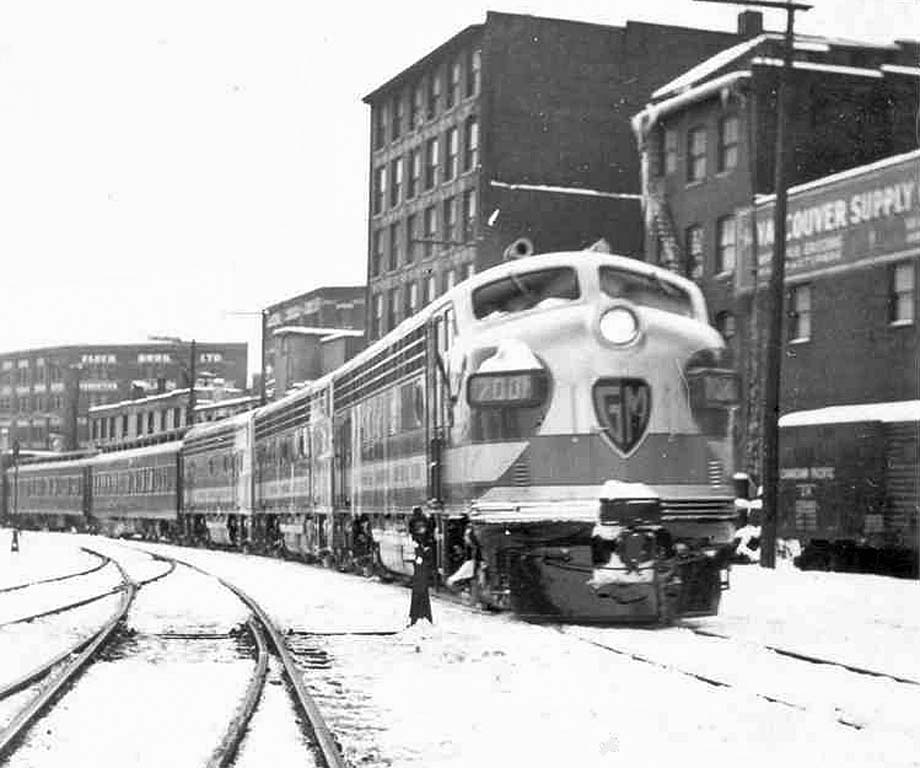
February-March, 1950
on Test Run

In a howling sub-zero blizzard at Field, B.C., 12 Jan 1950, Canada's westernmost province had its first look at a giant 359 ton three unit diesel locomotive which had been loaned to the Canadian Pacific for test purposes. The diesel, which had powered the Company's "Dominion" No. 7 from Montreal, was "reviewed" during its stopover at Field, enroute to Vancouver.
With the temperature at 14 below zero at the foot of Field's "Big Hill", weather conditions were ideal for many tests by which the C.P.R. and General Motors technicians and officials could judge the efficiency of the locomotive's performance under demanding mountain operating conditions.
Despite crisp temperatures, residents of Field, Golden, Revelstoke, and other points, turned out in droves to view what may be the herald of a new era in Canadian railroading.
For the majority of on-lookers, it was their first glimpse at a locomotive of this type. They stood in awe of its powerful but sleek-looking lines, and the manner in which it slid silently by the station platforms. The one thing which apparently impressed very strongly was the locomotive's horn, so unlike the steam whistles otherwise known throughout the mountains.
"Sounds like a boat whistle", said one grizzled, icicled, Field veteran. But of the locomotive he said, "she sure looks like a dandy".
Engineer "Pete" McDougal, of Revelstoke, asked how he liked the new engine, replied, "I was born 30 years too soon". McDougal has been with the Company over 40 years.
At Revelstoke officials expressed themselves "very satisfied" with the performance of the test diesel. Further tests are to be made with the locomotive on its east-bound trip.
British Columbia officials who met the test locomotive at Field included Chas Reid superintendent Revelstoke, George Nowell district master mechanic Vancouver, R.A. Davis division master mechanic Revelstoke, and S.T. Lea road foreman of engines Vancouver.
Because of unusually severe weather conditions prevailing throughout the Pacific Region, the diesel-powered transcontinental train was handled with the greatest care to prevent possible freezing and stalling owing to zero winds and drifting snow. A preceding passenger train out of Field for Vancouver required a pusher to help lift it out of hard, wind-packed snow which had drifted under the coach wheels. The diesel, however, after taking a supply of water for its heating plant, and fuel for its motors, proceeded on its journey without help.
Up the grade through the five-mile-long Connaught Tunnel, and bucking the 40 m.p.h. wind from the tunnel's powerful fans, the diesel moved effortlessly and steadily, maintaining the 30 m.p.h. speed limit through the "big hole".
The cab-in-front arrangement of the test diesel provided a new thrill for engineer and fireman operating the locomotive over the mountain subdivision from Field to Revelstoke. For the first time they were able to observe both sides of the track which snakes through 125 miles of spectacular railroad setting, with its numbers of snowsheds and tunnels.
Hundreds from Revelstoke, long the home of the giant 5900 class steam locomotive, turned out to view the streamlined diesel with a mixture of admiration and curiosity. The train remained at Revelstoke for the regulation 20 minute stop and many took advantage of the opportunity to inspect the locomotive cab and examine the interior workings of the power units.
On arrival at Vancouver the following day (Friday, 13 Jan 1950), the diesel was shopped and checked, and on Saturday was placed on exhibition together with selected passenger equipment, including one of the latest type day coaches.
During the exhibition, which was staged from 10:30 until 15:00 in the afternoon, an estimated 4,126 persons braved the near-zero temperature of one of Vancouver's coldest days, and thronged the station platform for a close-up view of the streamlined giant.
The big reception accorded the test diesel on the Pacific region was typical of the interest it attracted at other Company points in both eastern and western Canada, particularly at the larger terminals and divisional points.
Those reviewing the sleek 359 ton mobile powerhouse included railroad men of practically every description as well as thousands of interested spectators in other walks of life. Few were more enthusiastic than the droves of young boys (many of them aspiring young engineers) who gave their 4,500 h.p. hero a worshipful going-over during noon recesses and after four.
The engine was spotted at conveniently accessible points while on public exhibit. At Winnipeg, for instance, it was spotted on the south track of the subway over Main Street from 10:00 until 19:30, adjacent to the Royal Alexandra Hotel. The three units of the diesel were accompanied by a latest type day coach and roomette sleeper.
 and is reprinted here with their permission. All photographs,
logos, and trademarks are the property of the Canadian Pacific Railway
Company.
and is reprinted here with their permission. All photographs,
logos, and trademarks are the property of the Canadian Pacific Railway
Company.
